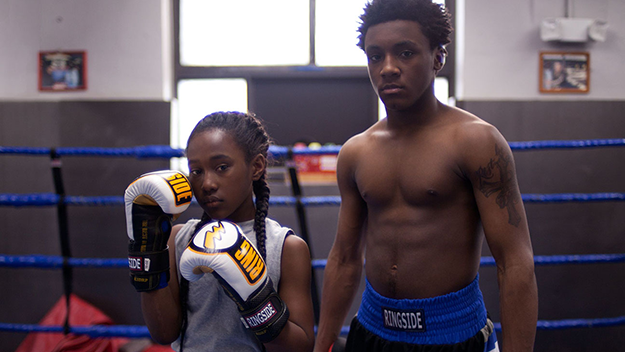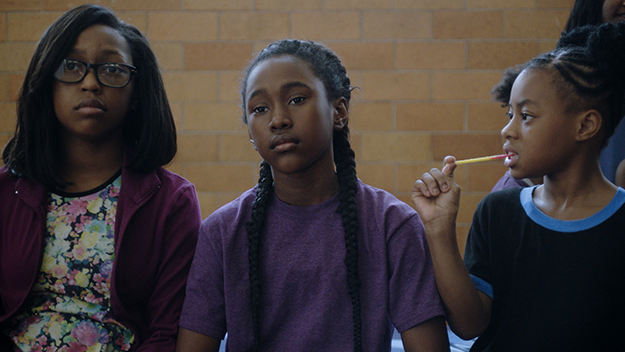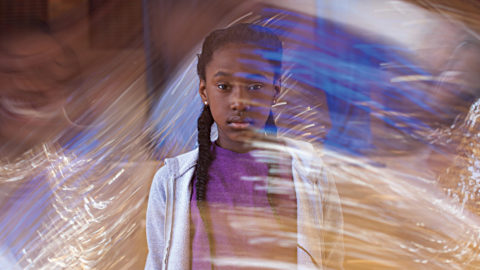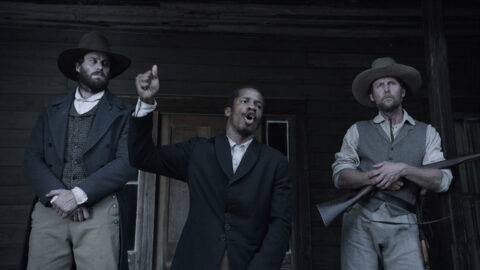Interview: Anna Rose Holmer, Saela Davis & Lisa Kjerulff
Making a feature with an entire dance team of preteen and teenage girls raises the usual challenges of a first film to another level. Anna Rose Holmer’s directorial debut, The Fits, exudes confidence and speaks with a distinctive voice. The film follows 9-year-old Toni (dancer Royalty Hightower), a Cincinnati tomboy who gives up after-school boxing with her brother to start dancing. As she struggles to learn the moves and stay on the team, the captains begin experiencing convulsions that disrupt rehearsals and lead to disqualifications from competition. No one is able to ascertain the cause, even as more girls become afflicted.
A coming-of-age story distinguished by more than its determined yet solitary protagonist, the beautifully constructed film is by turns deeply poignant and laugh-out-loud funny. Despite the offbeat premise, its setting and characters speaks directly to a desire for, as screenwriter Saela Davis put it, “just telling a normal story about normal people.” Last week FILM COMMENT spoke with the director and her co-writers Davis and Lisa Kjerulff, who together are part of the production collective Yes, Ma’am!. The Fits screens on March 19 and 20 during New Directors / New Films, and will have a theatrical run in June.
Anna, you started off as an AC doing focus pulling on shoots, and so much of the film’s look involves playing with focus. How much of that was built into the script, and how much was determined on location?
Anna Rose Holmer: My DP, Paul Yee, and I really talked about how we could use cinematic tools to isolate Toni. Some of those were focal point choices. We used old vintage prime lenses that had a really nice halo effect—the image fell out of focus with the edge of the frame. We decided to shoot widescreen, another way to kind of make sure that even when we were doing a portrait of Toni, there was an empty space around her. So that sense of isolation was built into the cinematic look, but that kind of tone was in the script that Saela [Davis] and Lisa [Kjerulff] and I wrote together.
When I was watching the film, I was struck by how you never see her in class, you never see her at home—she’s always with her friends or having these very personal, intimate moments by herself. It’s exactly how I remember that time of my life. Can you talk about structuring the script? Was it always very focused on her, or did you start off having more scenes with her family and then pare it down?
ARH: Saela is also an editor so she had really lean and pragmatic story sense that she brought to the writing process. We actually knew so much about the constraints of making this film—the timeline and the budget—that we tried to challenge ourselves not to write scenes that we didn’t see on screen. The shift towards it being Toni’s story is something that happened in the writing process.
Lisa Kjerulff: It was always sort of there because the three of us were collaborating and bringing our own experiences of growing up to that character. That was a big focus in creating the story: building that personal kind of experience. And, at least for me, growing up, the most formative and memorable moments end up being not necessarily with my family, but the social things that happen with my peers and my friends.
Saela Davis: Yeah. I think from the beginning we knew it was going to be about a very specific moment in a girl’s life, and we all talked about that experience with each other. I think a lot of us dealt with isolation in that point in our lives, and we all also had similar experiences with being tomboys and kind of coming into what it’s like to be more feminine. So I think we knew it was going to be focused on this specific time for Toni, and I think the story came naturally from our experiences.
Can you talk where the story about uncontrollable fits came from? Historically, hysteria was conceived of as this specifically female madness where you would lose bodily control—and it was completely tied up with female sexuality.
ARH: Yeah, I’ve been really fascinated with contagions and hysterics, and the conflation of that with female identity. But for me, the real seed of the film was while Saela and I were working on Ballet 422 together. I was really fascinated watching dancers learning how to dance and the body mirroring that goes into choreography and learning choreography. I started thinking of adolescence as this dance that you have to learn, where you look toward other bodies to define your own—that kind of social body mirroring. I felt like that was a really good place to set this story.
We translated our original idea into the world of drill and the community in the West End. It wasn’t at all part of the initial spark. It was very easy to translate—we learned a lot—we needed to listen a lot and be open to lots of authors giving their voice, and that was what our process was about. There was almost nothing that we needed to fundamentally change about the core values of the story when we set it in that community.
In the writing process, would you three get together to write or would you write separately and then bring those pieces together?
LK: Because we worked with the Venice Biennale we had to submit a step outline based on our treatment. So that was our first step: what are the story points? For the most part, we would get together and discuss the characters, and Anna would go off and write it out. Then we would discuss the story points based on the characters and the decisions that they’re making and all of the problems with everything. After that, Anna would go and write out the details that we had discussed and then we would tear it apart again.
ARH: I resisted the writing process pretty heavily, and I think it was Lisa and Saela who were holding me accountable for translating the film that we were talking about into a map that we could turn into a film. The document needed to articulate a lot—it was a very detailed document, aka a “screenplay.” They held me accountable because we were working at such a crazy speed. We knew we were going into production in a few months. You know, making sure that what were talking about in the room was on the page. And I don’t think we could have achieved that type of detail if it wasn’t a collaboration, if it wasn’t vocalized.
SD: I think also that we are very visual storytellers, and we were reluctant to speak the words of what we knew were going to be these teenage and pre-teen girls. But we forced ourselves to sit down and think about what our experiences were when we were teenagers and how did we say them—even though it’s different now. We had to tell this story with voices that we knew would definitely change once Anna and Lisa were on set.
So Royalty and the other actresses would improvise based on what you had written?
ARH: Yeah, we always wanted the dialogue to be something that we workshopped with the actors. One, because, like what Saela says, we’re all thirty-ish, and the way that teenagers talk now is different, and we didn’t grow up in the inner city in Cincinnati, and we all have different backgrounds and wanted to leave those things open. We also wanted to invite the girls to be authors of the characters that they were representing on screen. Some of the actors pretty much went with the script, some totally changed every word, and actors like Royalty—she had almost no lines in the script and she crossed out about half of the lines that she had, so she had even fewer lines. And she was like, I’m already saying this, this, this, and this, I don’t need to vocalize it. So we found other ways to give her the meaning of those lines in her actions.
At what point did you guys decide to set the film in Cincinnati, and specifically that community center?
LK: Really early on all we had was a treatment and a step outline, and Anna and I started researching different kinds of dance. She was watching YouTube videos and through a series of recommendations she came across one of the Q-Kidz, which is a dance team in Cincinnati, and immediately—I think it was like two 6-year-olds doing a stand battle [a dance-off]—it was a connection that this is kind of dance and these are the girls that make sense for the film. And so, the great thing about knowing that from such an early stage is that we were able to build a lot of the story and the script based around that environment.
ARH: The Q-Kidz were the only dance team that we asked to be part of the film, formally. And one of the seeds we had was that we wanted to cast all the girls from the same dance team, so in casting the Q-Kidz, once they came on board, we knew we had to shoot in Cincinnati and do production there. And the community center and the West End community—the larger community—was so supportive and generous from the moment we landed.
SD: When we were writing this, we had a rec center in our heads. And we started throwing out little things—like a pool or certain spaces within the rec center—but we had no idea if they existed or not. I remember Anna calling on the first scout of the location and being like, this is exactly what we wrote! It was very serendipitous, and I thought that was funny.
Can you talk a little bit about the music? Anna, you had mentioned in an interview that you had worked with these musicians before and that you had really wanted to create an interior soundtrack for what Toni was going through.
ARH: Yeah, Danny Bensi and Saunder Jurriaans scored Lisa’s previous film that she did with Nick Bentgen called Northern Light [13], so they were in our arsenal of friends. Saela and I watched the first cut of the film, and had very strong, different ideas of the role that music was going to play, and knew we needed something to give the audience a clue into Toni’s interior space before the fits started happening—to set the tone and to really give the audiences a feeling of quiet discomfort. So Danny and Saunder saw a really early cut and we just talked a lot about breath and using the instrument like a body so you could hear it breathing. Also we had our sound designer, Chris Foster, on even before we started shooting so he collaborated pretty heavily with them. Soundscape and score are really closely related in the film.
SD: With Chris we went back and forth with these soundscapes we were building. We wanted the sound to be just as musical as the actual score. And we had an idea about Toni’s internal state—that was definitely going to be expressed through the sound (and movement as well) because she isn’t so vocal all the time, so we knew we needed another element to express what she was feeling.
How did you approach working with the dancers and working with Royalty? They’re not really children, they’re teenagers, so you’re working with a different level of emotional intelligence.
ARH: We didn’t treat it any differently than working with anyone else. You come to set and you try to create a really safe space where people can experiment, can bring their voice to the table. And if you’re asking anyone to be emotionally vulnerable and open, you have to mirror that, you have to do that yourself. I was talking about this last night—kids call out bullshit so fast! [Laughter] And if you’re being inauthentic, it’s very apparent. So, not just from a directorial standpoint, but our gaffer and our choreographer and everyone on set had to be there in a very authentic, present, vulnerable, and joyful way. And that made it a really kind of cool set experience. It was led by these kids who are elite athletes and exceptional kids to begin with.
LK: As far as all of the kids we worked with and teenagers, from the very beginning they already had a wonderful sense of discipline and respect. Not only respect for adults, but respect for each other. The wonderful thing about working with Ms Quicy, the coach of the Q-Kidz, and her team, is that her philosophy for all of the girls is one of love and empowerment and respect for them, which was such a great environment to go into. Half of our crew was from New York and half was from Cincinnati, and it was wonderful working with all of them because everyone was really excited about the film.
ARH: And in terms of just actor craft, working with professional actors—or, I should say, actors who do it all the time—they know their ins, they know their styles, they know how they want to be directed. And for each of the kids in this film, they had to discover that while we were actually shooting. So it became pretty clear we had lots of different styles of actors who needed different types of direction. And that became our main focus: giving them what they needed to be in the moment, to explore, and be authors alongside us. With Royalty, she was a particularly physical actor, and we definitely did a lot of exercises to maintain that physical tension to her body. We would do sprints and little tiny tweaks, like small muscle minutiae. We developed our own very bizarre weird kind of language over the course of filming. It was very special to me. I think she’s beyond gifted and a real collaborator at age 9. It’s crazy.
She had to learn how to box, right?
ARH: Yes.
Were you there for that process?
ARH: Yeah. We trained with Queen City Boxing [Club]. She had a professional boxing coach who is part of the community center, Mr. Frank, and he did the early stage conditioning for her. Then we did two weeks of boxing training with Da’Sean Minor. He’s a junior Olympian who plays Jermaine in the film—and that was their process of becoming brother and sister, the boxing training. It was really special to witness that relationship blooming.
My colleague Eric Hynes mentioned something special I totally agree with: it’s cool that the brother-sister relationship isn’t antagonistic. They just get along, and it’s the antithesis of any terrible sitcom or film. Was that always built in or was that developed?
LK: I think that was sort of built in. We all have older brothers and, at least for me, that was kind of my relationship with my brother
ARH: Same. I idolized my older brother. And it was a very tricky thing with the script to not make him a plot obstacle. We had to do a lot to protect that relationship and how we envisioned it: he couldn’t say no, he couldn’t say “You’re terrible,” “You’re ugly.” He couldn’t do those things because that actually took away agency from Toni’s decision to transition into this world, and so we needed to keep that relationship special. It fades, but that’s kind of what we all experienced with our brothers growing up.
SD: Jermaine started as two characters initially. When we blended those two characters into one, he had to be something very specific, but we drew it from our own experiences with our brothers. When you reflect on your relationships with your family, you reflect on the special moments—there are always specific things that you remember. And I think Jermaine is that version of a brother. In the writing process, if he were too overdramatized, it would get too in the way of the development of our main character and the focus of the story.
Can you talk a little bit about Yes, Ma’am!, and what your goals are for it?
ARH: It’s just a collective, it’s this group of women. We’re all developing a script together. But I think it was just more about finding people who you love to collaborate with—it’s so rare. Like I mentioned, this has been the peak of my creative satisfaction so far, and it would be crazy not to want to work together again.
There are a lot of diversity initiatives going on now. Do you think this current push is going to last?
ARH: That’s a really hard question. The process of working with these two women has been one of the most rewarding creative times in my life and I see it as a privilege. And I hope that, in terms of headlines, this isn’t about tokenism or click-bait or whatever. That this is actually a real conversation about what it means to have on-screen representation and behind-the-camera representation. I don’t want to be super Debbie Downer, but it wasn’t something we were thinking about. We were almost joking about it—how inclusive our little team was really special to us and rare. We never get to do this and work with this group of people.
LK: I hope that it’s not just a trend, and that the opportunities continue, and that more talented women and people of color and the broader spectrum of humanity continue to have more opportunities and the same opportunities as everyone else to just continue to create.
ARH: And to fail! Fail without it being—
LK: Fail without it being representative of all women! It’s like, oh, this one wasn’t good! It’s women! [Laughter]
SD: The most exciting thing about this process has been working with Anna and Lisa. And also I feel like our film definitely speaks to the talent behind the camera more than to who we are. I think it’s been empowering, and I hope we can make the next one and that people focus more on the craft than on who we are. But at the same time, I hope that we can lead the way for other women to be inspired and want to make films as well. I don’t know if I can articulate my feelings on it but it’s—
Well, it’s a big thing.
SD: It’s a big thing, yeah.
ARH: It’s kind of shocking that it’s still a big thing.
Yeah.
SD: I think I went into film school kind of being naïve to the idea that women don’t make movies as much as men and they’re not as present. And it was shocking to learn that in film school so early on. But I meet so many awesome women and diverse groups of people that are just as capable and I just hope that can continue and eventually one day not be an issue, but I know it still is.
ARH: We got to make a pretty experimental film with maybe some bigger risks, and we were totally funded by non-profit grants. So we didn’t have to be vetted by this industry machine that measures profits and likeability and clickability. We were given this beautiful gift by the Venice Biennale, and then we were further supported by the Sundance Institute, Cinereach, Rooftop, Women Make Movies, IFP. And those are all non-profits who are saying we need to change the game and support filmmakers that fall outside of this narrow spectrum. No financier would have ever looked at our initial idea and said yes—and we know that. So we took this privilege of this grant very seriously, and we were like, we’re going to do something that we couldn’t make in another way.









